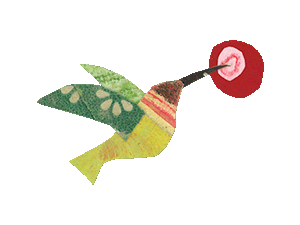There are as many ways to tell stories as there are people on the earth. The method we teach is what we call “intuitive storytelling,” meaning there is no preparation involved. You make the story up on the spot.
At first, this might sound harder than simply repeating a classic fairy tale, but once you grasp the essential structure—what we call the “storytelling loop”—you’ll discover that it’s as simple as walking. You don’t have to think about it in order to do it.
What we like about this method is that it allows every individual to express herself and her family’s values in diverse and unique ways. It’s a method that fits everyone because it’s about process, not content. And this diversity of expression lends itself well to parents, who need a range of stories for all of life’s varying events.
A beginner typically starts with whimsical stories, but a practiced storyteller begins to see how this simple method can be used to soothe a child in distress, teach valuable lessons, and make meaning of difficult situations. That’s what our book is all about, and it’s easier than you think.
Here’s How It Works
It starts by identifying one or two real and concrete things in your child’s environment. This could be a toy, a snack, a tree, or even an event. It can be a dryer sheet or a hole in the wall. Anything, so long as your child will recognize it. Then, you take this thing, this very real and recognizable thing, and tell a story about it. Two minutes is enough. When the story ends, your child will have this cool imaginative story, but she will also have a new perspective on that very real thing. In many cases, she will pick up the story (the invisible object) for herself and find new outlets for play and creativity. Where? Within the visible object, the anchor that you brought into the story.
This is the storytelling loop. You can think of it as a stitch between reality and imagination. A practiced storyteller has made many such stitches, weaving together a dense fabric of reality and imagination, and helping to fill her child’s world with all sorts of outlets for play and creative exploration – on both sides, reality and imagination.
We use it for teaching too (because storytelling helps us remember information), and it’s a very effective tool for soothing upset children, resolving conflict, and deriving meaning from difficult life events, even death.
In time, a child’s life becomes filled with these reminders - both of you, and of the imaginative world you helped open to her. The objects become like doorways, beckoning her to explore further. Such a child sees stories and creativity in the very walls of her house.
But what’s the number one benefit? The loving bond – which doctors call attachment – that is fostered between you and your child during a story.
An Example
A mother and her son are eating macaroni and cheese. At some point during the meal, the mother tells the boy that when she was a girl she accidentally spilled a box of macaroni all over the floor. She tried to clean it up, but it was late and she didn’t do it so well. The next morning, when she woke up, a friendly spider told her about how he went sliding down the macaroni tubes all night, jumping from one to the next, and had so much fun. “Uh oh,” she said, “I better clean them up or my mom will be upset.” But she gave the spider one of the tubes to keep. He dragged it to the bathtub, where he went sailing, then turned it into a submarine. It was a great adventure.
We guarantee you that after this story, both mother and son will have a new relationship to the noodles on their plates. But what else do they have? A loving bond, a memory, and a reason to tell more.
This is the storytelling loop. We have a reality, a concrete something. Then we tell a story about it. Afterward, we have a new relationship to that very real thing. This is pretty cool in and of itself, but what’s even more interesting is the intimacy and trust that grows between parent and child through the shared experience of storytelling over months and years. This story, for example, is whimsical, which is where most parents will start. It’s fun. But in time, you will use this storytelling relationship to help make meaning of all sorts of experiences in life.
Now You Try It
The method is very simple, and you’ll find that practice is more fruitful than memorizing strict rules. The important lesson is that storytelling comes naturally to everyone. It’s a skill that lies deep inside you. Trust yourself.
And if you want further ideas, you’ll find lots more in our book and in our newsletter.


